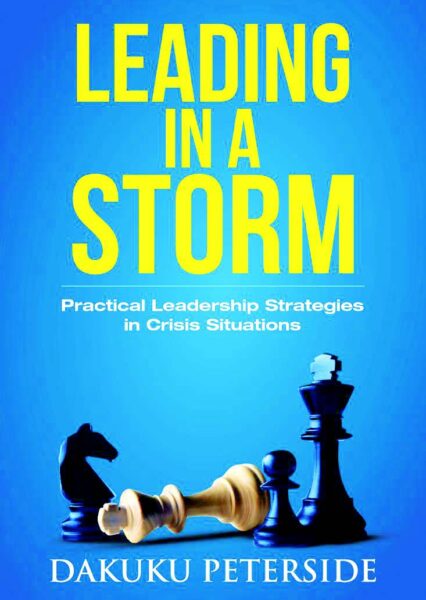0
Let me begin by expressing my profound gratitude to the author, Dr. Dakuku Peterside, for the great honour of inviting me to review this remarkable book. Standing here today is not just a privilege, it is also a humbling responsibility, to engage a work that will, without question, shape the way leaders in our time think about and practice leadership when the storms of life and history press against them.
I have been asked to review this great body of knowledge titled; Leading in a Storm: Practical Leadership Strategies in Crisis Situations published by Safari books.
Sir, once again, thank you for entrusting me with this task. Reviewing a book is one thing; reviewing a book of this depth, breadth, and timeliness is quite another. It is a book, a well-researched project, a mirror, and a call to action. And it could not have come at a more urgent time in our national and global journey.
The book is divided into nine chapters, each exploring a distinct competency of crisis leadership. I must say that the work done here is practical and narrative-driven, research-informed and case-rich; it truly blends in academic insight with lived experience, theory with application. And each chapter flows into key points and reflection questions, designed for growth and learning. I am particularly excited that it is rooted in African contexts yet globally attuned, it connects leadership theory to local realities. From a literary standpoint, it is written in clear, instructional prose that fuses storytelling, strategy, and scholarship into one seamless experience. Quite a rich one.

Why This Book Matters Now
We live in a world where crises are no longer episodic interruptions; they have become recurring conditions of leadership. Whether it is economic instability, pandemics, political unrest, or institutional breakdowns, today’s leaders are constantly being thrust into the heart of chaos.
The opening question by the author in the prologue is just intriguing.
“Imagine being thrust into the heart of chaos: No warnings, no rulebook, and no guarantees. You’re the pilot midair when turbulence hits relentlessly for three hours. The CEO of a booming enterprise as protests erupt in every region you operate in. A port director facing a global supply chain catastrophe. A captain of a ship that is sinking. A mayor confronting citywide blackouts with livelihoods at stake. What would you do?”
“…The leaders who thrive aren’t those who avoid crisis, but those who’ve learned to navigate it with skill and confidence.”
It reminds us that crises are not just problems to be managed. They are crucibles that test, refine, and reveal leadership. They are the moments when leaders must show not just competence, but character; not just capacity, but courage.
This is why I believe the book is not just relevant; it is indispensable.
The Intellectual Core of the Book
Dr. Peterside distils five years of rigorous research into a clear and practical framework of eight key competencies that enable leaders and institutions to perform effectively under acute pressure.
These eight competencies are:
1. Contextual intelligence — the ability to read situations accurately.
2. Calm confidence — the composure that steadies others.
3. Sense-making — bringing clarity out of confusion.
4. Strategic decision-making — choosing wisely under pressure.
5. Clear communication — using words to unify, not divide.
6. Strategic flexibility — adapting as conditions shift.
7. Coordinating teamwork — aligning diverse actors.
8. Facilitating learning — ensuring we do not waste a crisis.
What strikes me here is not only the clarity of the framework but its architecture. Notice how he begins with contextual intelligence as the foundation: before you act, you must first see and understand. From there, he builds to emotional, cognitive, and social skills that, when combined, give leaders the agility to stand in the storm without being swept away.
And these are not presented as a checklist. The book shows how they interdepend, calm confidence makes clear communication possible, sense-making fuels flexibility, teamwork drives effective learning.
The author insists that crisis leadership isn’t a mysterious talent that some people are born with and others cannot acquire. It’s a set of learnable skills, a way of thinking that can be developed, and behaviours that can be practised and refined and believes that we can a fundamentally have a different relationship with uncertainty. Instead of seeing crisis as something to be feared and avoided, we understand it as something that can be navigated with skill and purpose.
What makes this book compelling again is the vivid historical narratives and case studies.
We encounter Nelson Mandela in the tense hours after the assassination of Chris Hani, modelling calmness and using rhetoric to pull a nation back from the brink of civil war.
We meet Luis Urzua, the shift foreman during the Chilean mine disaster, whose steady leadership turned panic into purposeful collaboration underground.
We reflect on the entertainers aboard the sinking Oceanos cruise ship, who became unexpected leaders by lifting morale when the official captain had abandoned ship.
And closer home, we examine responses to Ebola in Liberia, protests like #FeesMustFall in South Africa, and even our own national crises here in Nigeria.
The stories are asking a clear question, what would you do if you were thrust into such storms?
The author hits the nail on the head when he identified; preparing for an event that is yet to happen; making quick decisions when the unexpected happens; and taking decisive action in the face of unanticipated challenges as the core of what crisis leadership is all about.
To these, I would add one more, mind leadership – with emphasis on developing one’s internal environment to handle external aggression. True leadership strength is forged within; it is the discipline of mastering one’s emotions, mindset, and energy so that chaos outside does not distort clarity within.
Practical Value for Leaders
The author did not leave us at the level of theory. Each chapter ends with reflection questions, exercises, and strategies. This makes the book something to read and practice.
A policymaker, a CEO, a military officer, or even a student leader can close each chapter with actionable insights they can begin to work on immediately.
It is, in many ways, a training manual disguised as a book.
A Gentle Suggestion
If I may add a gentle suggestion; I believe the book would benefit from a one-page executive toolkit: a distilled checklist or decision tree that leaders can carry in their pockets or pin to their desks for quick reference in the middle of a storm. The content is all there in the chapters; condensing it into a ready-to-use tool will make it even more powerful for busy practitioners.
I agree that the privileged position of being the reviewer is just a decorated name for CHIEF OPINION OFFICER; to answer the biggest question of the night – what do I think of this book?
I think it is a rare blend: empirically rigorous, richly illustrated, and insistently practical. It speaks not only to academics but to practitioners. It is rooted in African realities yet global in its lessons.
And I am glad that my sentiments are echoed by other phenomenal experts who affirm the book’s relevance in these turbulent times. From Loran Nordgren, who describes it as a blueprint for navigating crises across technology, politics, and the environment, to Andrew Sykes, who calls it essential reading for the modern leader moving from one crisis to the next. Phillip Humm highlights its powerful insights, stories, and tools for adapting and leading with confidence, while Dr. Toye Sobande commends its contextual grounding in Africa and emphasis on calm, communication, and clarity in chaos. For Hugh O’Doherty of Harvard, it is a practical manual for leading through uncertainty, and Prof. Tunji Olaopa aptly captures its essence as a defining contribution to the making of crisis leaders the world sorely needs today.
Dr. Peterside, I thank you again for this gift to the world of leadership. Your work will equip a generation of leaders to stand not only when the weather is fair, but when the storms rage most fiercely.
And so, ladies and gentlemen, I commend Leading in a Storm to you all. Read it. Reflect on it. Practice it. Because the storms will come, but with the right competencies, we can all learn not only to survive them, but to lead through them.
*Okorie is a leadership and human capital development consultant








